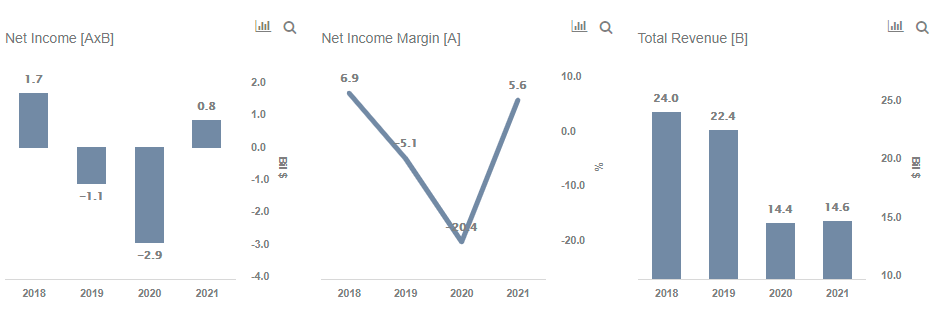Hold Halliburton Stock For Long Term Gains
Despite subdued rig count figures and broader macroeconomic weakness, the shares of Halliburton (NYSE: HAL) have recovered to the levels observed before the March 2020 crash. This can largely be attributed to production curtailments by the OPEC and stable benchmark prices. With upstream companies continuing to curtail capital and operational expenses in 2021, oil field service firms including Halliburton have been shifting focus toward their software businesses. In order to enhance its digital solutions offerings, Halliburton partnered with Microsoft and Accenture last year. As the company incurred $3.8 billion of impairment charges in 2020, its digital business is expected to be the key revenue and earnings driver in 2021. We highlight quarterly revenue trends for the company along with our estimates for Q1 2021 and the full-year 2021 in an interactive dashboard, Halliburton Earnings Preview.
Halliburton generated $638 million of operating cash in Q4 2020
As the number of daily infections trended downward in Q4 2020, an uptick in macroeconomic activity along with OPEC’s mandatory curtailments pushed benchmark prices higher. Halliburton’s business is largely linked to the demand for new oil & gas wells, and higher rig count figures led to a sequential improvement in the company’s top line in Q4. Interestingly, the trend continued even in Q1 2021 as OPEC decided to ease production cuts on an ongoing basis. Thus, the U.S. upstream companies benefited from rising crude oil demand. However, crude oil prices are expected to observe a downside during the latter half of the year as OPEC increases supply and inventory pressure builds up in the U.S. and other countries.
- Up 7% This Year, Will Halliburton’s Gains Continue Following Q1 Results?
- What To Expect From Halliburton’s Q3 After Stock Up 10% This Year?
- What To Expect From Halliburton’s Stock?
- Can Halliburton Stock Return To Its Pre-Inflation Shock Highs?
- Halliburton Stock Likely To See Higher Levels Post Q1 Results
- What to Watch For In Halliburton’s Stock Post Q4?
How has HAL stock fared in comparison to the S&P 500?
HAL stock declined from levels of around $22 in February 2020 (pre-crisis peak) to levels of around $5 in March 2020 (as the markets bottomed out), implying HAL stock lost 77% from its approximate pre-crisis peak. With the easing of restriction measures, the stock has more than doubled to $20 but, the newly imposed restriction measures in Europe and prevalence of the U.K. strain across the world are a concern for the global economy. Thus, the stock is likely to observe headwinds in the near term.
The coronavirus pandemic has created many pricing discontinuities which can offer attractive trading opportunities. For example, you’ll be surprised how the stock valuation for New Jersey Resources vs. World Wrestling Entertainment shows a disconnect with their relative operational growth. You can find many such discontinuous pairs here.
See all Trefis Price Estimates and Download Trefis Data here
What’s behind Trefis? See How It’s Powering New Collaboration and What-Ifs For CFOs and Finance Teams | Product, R&D, and Marketing Teams

